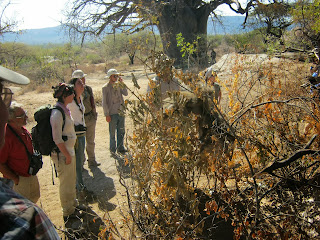The Hadza are
a
unique population of hunter-gatherers living in the Lake
Eyasi region of northern Tanzania. Their way of life
dates back millennia, living off of the land by hunting
wild game, collecting wild plants and honey, and sleeping
in simple grass huts in the dry African
savannah. The Hadza are familiar with the
outside world of towns and technology, but while they are
gracious neighbors most have chosen to follow the life
ways of their parents and grandparents, keeping their
vibrant and fascinating culture alive. Below there photos in the first one is the Hadza with some of the cultural tourists and the second photo is a meat of a hunted game and their simple house made up of grasses
The Hadza are not closely genetically related to any other people. While traditionally classified with the Khoisan languages, primarily because it has clicks, the Hadza language appears to be an isolate, unrelated to any other.
The descendants of Tanzania's aboriginal hunter-gatherer population,
they have probably occupied their current territory for several thousand
years, with relatively little modification to their basic way of life
until the past hundred years.
some cultural tourists watching the baboon skin after been slaughter by the Hadza.
A baobao tree with some of the Hadza bows and arrows which the Hadza men use when they hunt wild animals and also they are sold to some of the cultural tourists.
The skin of the wild game that is drying on the surface.





Hakuna maoni:
Chapisha Maoni